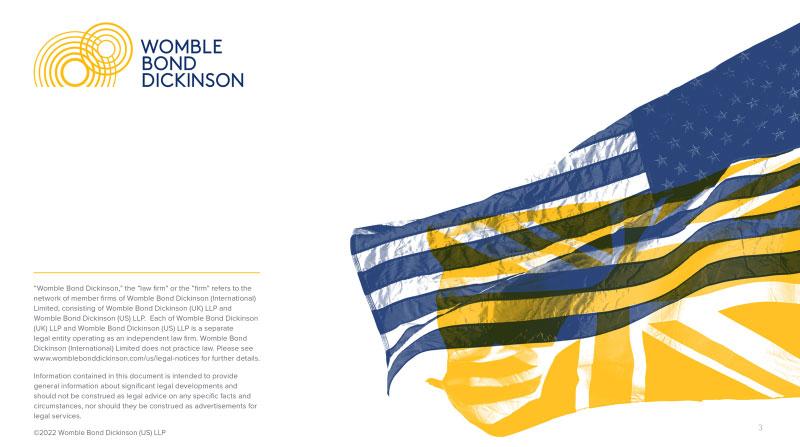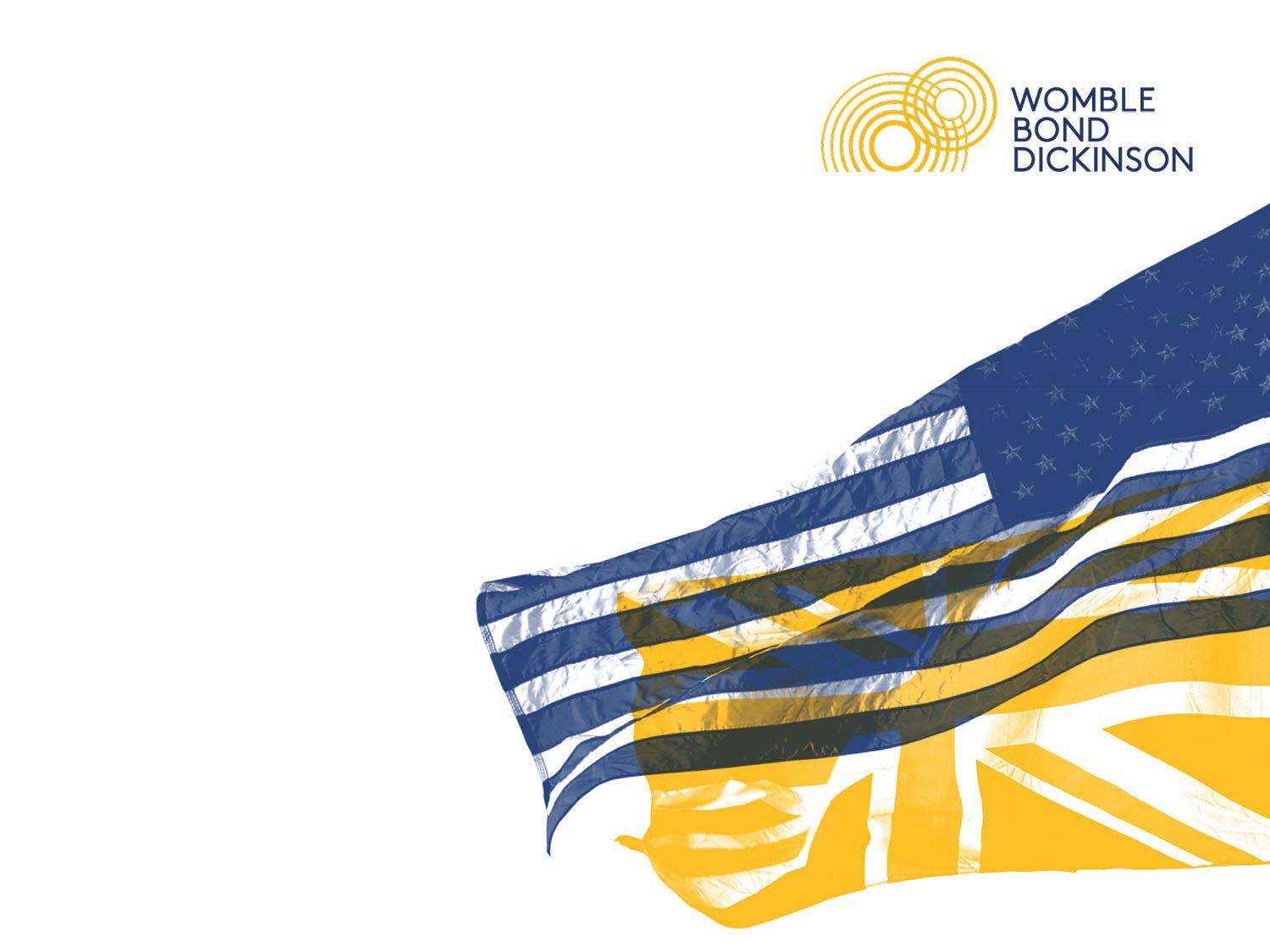






Conducting Investigations
Drafting
Decision-making
Drafting Notices of Determination

• Welcome • About
• About you
• About the work we all do

Training Requirements for Investigators:
Definition
Scope of your programs/activities
How
How to serve impartially and without bias and conflict of interest and without prejudgment
Issues of relevance to draft reports that fairly summarize evidence*
Conducting
Maintain training records (7 years) and post on website


LegalUpdates




Legal Updates
Final Regs – effective August 2020
July 20, 2021 Q&A
LGBTQ guidance
Victim Rights Law Center et al. v. Cardona et al.
Civil Action No. 20-11104-WGY, 2021 WL 3185743 (D. Mass.)
OCR Letter to Students, Educators, and other Stakeholders re Victim Rights Law Center et al. v. Cardona (August 24, 2021)
• New Notice of Proposed Rulemaking Released –July 2022
• Notice and Comment to NPRM closed (9/12/22) –240,000+ comments submitted!
• Now we wait….

Legal Updates —Proposed Regs
• Broader definition of “Sex-Based Harassment”
• New hostile environment harassment definition
• Off-campus conduct, including conduct outside the U.S.
• Oral complaints permissible
Live hearings not required but live questioning in some form
Single investigator model permitted
Flexibility to narrow the scope of the evidence review
Employee notification requirements
Pregnancy
Training will continue to be required

Legal Requirements –Title IX (20 U.S.C. § 1681)
“No person in the United States shall, on the basis of sex, be excluded from participation in, be denied the benefits of, or be subjected to discrimination under any education program or activity receiving Federal financial assistance” and Requirements contained in August 2020, Final Regulations:
Apply to all institutions that receive federal funds, including financial assistance
Cover students, employees, and third parties
Include all forms of discrimination based on sex such as sexual harassment and differential treatment
• Enforced by the Office for Civil Rights and courts

Legal Requirements –Violence Against Women Act (“VAWA”)
Amended Clery Act through the Campus Sexual Violence Act (“SaVE Act”) provision, Section 304
• Added domestic violence, dating violence, and stalking to the Clery crimes (which already included sexual assault)
Requires adoption of institutional policies and procedures to address and prevent campus sexual violence
• Requires training of institutional personnel and students
Requires prevention and awareness programs
Clery Act Enforcement

“Recipients” of federal funds must:
• Disseminate a policy that includes a Notice of Nondiscrimination
• Designate a Title IX Coordinator
• Adopt, publish, and follow grievance procedures that are equitable, prompt, and effective and provide for adequate, thorough, reliable, fair, and impartial investigations and adjudications
• Take action to address and prevent sex-based discrimination
Train individuals serving in specified roles

Other Applicable Laws
Family Educational Rights and Privacy Act (FERPA)
Exceptions under Title IX and VAWA for files shared during the process that permit disclosure of materials the laws require to be shared
Remedies are not shared except as necessary to enforce them (Title IX exception is for sharing the fact remedies were provided but not the details)
• Title VII
• Americans with Disabilities Act, Section 504 of the Rehabilitation Act (Disability and Accommodations)
Mandatory reporting laws requiring the reporting of child abuse and neglect
• State laws

Legal Requirements: The Fundamental Obligation
Under Title IX, an institution is obligated to respond when: it has “actual knowledge” of “sexual harassment” involving a person who is participating or attempting to participate in an “education program or activity” of the institution and when the sexual harassment is directed against a person in the United States
VAWA protections:
• Allegation of sexual assault, dating violence, domestic violence, or stalking
• Involving student or employee
• Regardless of location and participation in program/activity












“means





Legal Requirements: Title IX Sexual Harassment Defined
Conduct on the basis of sex that satisfies one or more of the following:
(1) Quid pro quo: an employee conditions an aid, benefit, or service of recipient on an individual’s participation in unwelcome sexual conduct;
(2) Hostile environment: unwelcome conduct determined by a reasonable person to be so severe, pervasive, and objectively offensive that it effectively denies a person equal access to the recipient’s education program or activity; or
(3) “sexual assault,” “dating violence,” “domestic violence,” or “stalking”

Legal
Sexual Assault: Any sexual act direct against another person, without the consent of the victim, including instances where the victim is incapable of giving consent. This includes:
• Rape: Carnal knowledge of a person, without the consent of the victim, including instances where the victim is incapable of giving consent because of his/her age or because of his/her temporary or permanent mental or physical incapacity.
Sodomy: Oral or anal sexual intercourse with another person, without the consent of the victim, including instances where the victim is incapable of giving consent because of his/her age or because of his/her temporary or permanent mental or physical incapacity.

Legal Requirements: Title IX Sexual Harassment Defined
Sexual Assault (cont.):
Fondling: The touching of the private body parts of another person for the purpose of sexual gratification, without the consent of the victim, including instances where the victim is incapable of giving consent because of his/her age or because of his/her temporary or permanent mental or physical incapacity
• Incest: Sexual intercourse between persons who are related to each other within the degrees wherein marriage is prohibited by law.
• Statutory Rape: Sexual intercourse with a person who is under the statutory age of consent.

•
Dating

•
•Course




• Locations, events, or circumstances over which the recipient exercised substantial control over both the respondent and the context in which the sexual harassment occurs
• On campus or
• Off campus, when: Part of the recipient’s operations
• Occurs at any building owned or controlled by an officially recognized student organization (e.g., fraternities and sororities)



•
•















Reports vs. Formal Complaints
•

3.
1.









Formal Grievance Process
Basic Requirements:
No bias or conflicts of interest (as to party type generally or individuals)
Training required for all roles!
• Treat parties equitably
Participation in process and submission of evidence
• Advisors and limits to participation (cannot limit cross-examination)
Access to directly related and relevant evidence
• Follow Grievance Process before imposing sanctions or other non-supportive measures
• Remedies designed to restore or preserve access to education or activity (need not be non-disciplinary or non-punitive) –occurs after a determination of responsibility

Formal Grievance Process
Basic Requirements (cont.):
• Describe range of supportive measures
• Remedies are often extensions of supportive/interim measures Complainant received during process Presumption of not responsible
• State the standard of evidence and use the same one for all Formal Complaints regardless of who the parties are Preponderance or clear and convincing
• Cannot seek to collect information protected by legally recognized privilege, unless the privilege has been waived
• Same for medical treatment records unless voluntary, written consent

Formal Grievance Process
Basic Requirements (cont.):
Reasonably prompt timeframes (temporary delays for good cause) For each phase of the process (some are specified in the Regs) With written notice to the parties citing reasons for delay and upon resuming investigation
• Good cause includes: absence of party, advisor orwitness;language assistance/disability accommodation; or concurrent law enforcement activity (brief, for fact gathering, not criminal prosecution) –investigator’s workload notincluded as an example
• Objective evaluation of all evidence, inculpatory and exculpatory Credibility determinations cannot be based on status as Complainant, Respondent, or witness
• Describe range of sanctions and remedies
• Procedures and grounds for appeals
• Plus any other provisions, rules, or practices adopted by the institution


1.













Conducting Investigations


Overview of Investigation Phases
1) Roles and Pre-investigation work (done by Recipient)
2) Investigator Preparation
a. Knowledge of Policy Definitions
b. Prepare for Interviews
c. Trauma-Informed Education
3) Gather Evidence
4) Review and Summarize Evidence
5) Draft/Finalize Investigative Report for Decision-maker(s)


Understanding Roles —Investigator’s Obligations
Undertake:
• “a thorough search for relevant facts and evidence
• pertaining to a particular case, while operating under the constraints of conducting and concluding the investigation under designated, reasonably prompt timeframes and without powers of subpoena.”
• “Such conditions limit the extensiveness or comprehensiveness of the efforts to gather evidence while reasonably expecting you to gather evidence that is available.”

Understanding Roles —Staying in Your Lane
Recipient’s Role
Investigator’s Role
•Participating

• Title IX Coordinator can be an investigator but cannot be a decision-maker
• Can make recommendations regarding findings
• Investigator cannot be a decision-maker (no single investigator model)
• Can make recommendations regarding findings
• BUT decision-maker, regardless of recommendations, must independently and objectively evaluate the relevant evidence (no deferential treatment) Understanding Roles —Title IX Regulations’ Dividing Lines

Understanding
Roles —Title IX Coordinator
Directly or through designee:
Coordinating the recipient’s response to discrimination on the basis of sex, including sexual harassment and misconduct
Ensuring process is free from known or reported conflicts of interest or bias
• Responding to reports alleging sexual harassment
Determining the appropriate process
Overseeing the grievance process
• Ensuring the process is user-friendly
Coordinating the effective implementation of supportive/interim measures
Overseeing training requirements
Separating roles and responsibilities
Ensuring process is compliant and effective

Investigation Phases: Pre-investigation Efforts by Others
Prior to commencement of the investigation:
• Receipt of report and/or formal complaint
Meeting(s) with Complainant and, often, Respondent
Safety and risk analysis (Complainant and community)
Removal process, if applicable (very rare)
Written notice of rights to Complainant and preservation of evidence (VAWA compliant)
• Notification of right to contact law enforcement (and note differences)
• Notification of right to obtain medical treatment
• Supportive/Interim measures
• Evaluate availability of informal resolution
Evaluate potential grounds for dismissal
Decision to move forward with an investigation
Determination of which policy/process will be followed

Investigation Phases: Pre-investigation Written Notice Requirement
Prior to commencement of the investigation (cont.):
Upon receipt of the Formal Complaint, must send parties Written Notice:
Explaining grievance process
Containing sufficient details known at that time (and supplement later as necessary)and provided with sufficient time to prepare a response before any interview, including:
identities of the parties (if known)
conduct constituting sexual harassment date and location of alleged incident(s) (if known)
Stating that respondent is presumed not responsible
Determination regarding responsibility is made at conclusion of the process
Informing parties of any policy provision that prohibits participants from knowingly making false statements/submitting false information

Written Notice (cont.):
Informing

•
•
But
•
Potted
•

• Decide what evidence is going to be included and excluded Ensure compliance with timeframes in policy and required by Title IX Understanding Roles —Coordination between Investigator and Title IX Coordinator
Decide whether to delay the investigation for good cause
Communicate notices of delay and recommencement of the investigation
Send any amended notice of allegations
Decide on close of evidence and deadlines to provide evidence
Decide to re-open an investigation to gather more evidence

Case Study: Annabelle and Jake
On November 3, 2021, the Title IX Coordinator received notification from the University’s online reporting system.
Annabelle alleges that Jake raped her when she was “too drunk,” “blacked out,” and after she told him “no.”


Conflicts?
In August 2022, the Title IX Coordinator reaches out to you to tell you that TBU has received a complaint that could involve the following:
Madison Morgan (TBU student)
Emily Evans (TBU student)
Annabelle Adams (TBU student)
Henry “Hank” Hughes (non-student)
• Jacob “Jake” Johns (TBU student)
• Michael Morris (TBU student)
Thoughts?


Annabelle and Jake: Notice of Allegations
In August 2022, Annabelle filed a formal complaint with the Title IX Coordinator. On August 25, 2022, the Coordinator sent the parties a Notice of Allegations, which identified you as the investigator, and stated, in part:
On August 24, 2022, Annabelle submitted a complaint alleging that Jake raped her. In her complaint, Annabelle alleged that Jake engaged in nonconsensual vaginal sex with her on October 31, 2021.


Preparation Phase —Prepare for Investigation
• Clear conflicts/bias inquiries
• Issue spotting and legwork:
• Review complaint, statements, documentation, notices to parties
• Gather available information about parties and witnesses
• Legwork on locations, geography, and publicly available information, including information, sources of information, and investigation steps
• Develop plan for sequencing investigation, interviews, and evidence
• Know the policy/policies at issue and the applicable procedures, provisions, and definitions
• Calendar the timeframes for the phases Outline your report and investigation steps

Preparation Phase —Prepare for Interviews
Account for the circumstances and surroundings:
• Who will be participating?
• Investigator(s)? Party? Advisor? Support person?
• By what method? In-person? Video? Other method? Recording?
• From what location(s)?
• Timing and sequencing
• Know applicable policy provisions around these items Go with the flow –be fluid and flexible

Case Study: Definition of Title IX Sexual Harassment
• The term “Title IX Sexual Harassment” means conduct on the basis of sex* that satisfies one or more of the following: An employee conditioning educational benefits on participation in unwelcome sexual conduct (quid pro quo); Unwelcome conduct that a reasonable person would determine is so severe, pervasive, and objectively offensive that it effectively denies a person equal access to the educational institution’s education program or activity; and/or Sexual Assault, Dating Violence, Domestic Violence, or Title IX Stalking
*including conduct based on sexual orientation and gender identity or expression

Case Study: Definition of Sexual Assault
• The term “sexual assault” includes the following actual or attempted acts:
• Rape (except Statutory Rape): The carnal knowledge of a person, without the consent of the victim, including instances where the victim is incapable of giving consent because of their age or because of their temporary or permanent mental or physical incapacity.

Case Study: Definition of Sexual Assault (cont.)
• Sodomy: Oral or anal sexual intercourse with another person, without the consent of the victim, including instances where the victim is incapable of giving consent because of their age or because of their temporary or permanent mental or physical incapacity.
• Fondling: The touching of the private body parts of another person for the purpose of sexual gratification, without the consent of the victim, including instances where the victim is incapable of giving consent because of their age or because of their temporary or permanent mental or physical incapacity.

• Sexual activity of any kind requires “consent,” which consists of the following:
Consent means clear and voluntary agreement between participants to engage in the specific act.
• Consent requires a clear “yes,” verbal or otherwise; it cannot be inferred from the absence of a “no.”
• Consent must be ongoing throughout a sexual encounter and can be revoked at any time.
Consent to some sexual acts does not necessarily imply consent to others.
• Past consent does not mean ongoing or future consent. Case Study: Definition of Consent

Case Study: Definition of Consent (cont.)
• Consent cannot be obtained by pressure, threats, coercion or force of any kind, whether mental or physical. Consent means actually agreeing to the specific sexual activity, rather than merely submitting as a result of pressure, threats, coercion or force of any kind, whether mental or physical.
• Consent cannot be obtained from an individual who is under the legal age of consent.
• Consent to engage in sexual activity with one person does not imply consent to engage in sexual activity with another.

Case Study: Definition of Consent and Incapacitation
Consent cannot be obtained from someone who is unconscious, asleep, physically helpless, or incapacitated (including, but not limited to, mentally incapacitated). A person is incapacitated when they are unable to make a rational decision because the person lacks the ability to understand their decision. A person who is incapacitated is unable to consent to sexual activity. A person can become incapacitated as a result of physical or mental disability, involuntary physical constraint, being asleep or unconscious, or consumption of alcohol or other drugs. A person can consume alcohol and/or drugs without becoming incapacitated. A person who engages in sexual activity with someone that person knows or reasonably should know is incapacitated does not have consent and will be found responsible for a Policy violation.

Case Study: Definition of Consent and Incapacitation
It is always risky to engage in sexual activity with someone who has been consuming alcohol or drugs. To assess whether a Respondent knew or should have known that a Complainant was incapacitated, the following factors may be considered:
Did the Complainant appear lucid to the Respondent and/or others?
• Was the Complainant’s speech slurred?
• Did the Complainant have glassy eyes or slowed eye movement?
• Was the Complainant vomiting?
Was the Complainant stumbling or having difficulty maintaining balance?
Was the Complainant able to support her/his/themself?

Case
Study: Definition of Sexual Exploitation
Sexual Exploitation is the taking sexual advantage of another person or of the sexuality of another person for the benefit of another person, without consent, or in a manner that extends the bounds of consensual activity. Examples of sexual exploitation include, but are not limited to, the following:
Observing another individual's nudity or sexual activity or allowing another to observe nudity or sexualactivityin a place where that person would have a reasonable expectation of privacy without the consent of allpartiesinvolved; Intentional invasion of a person’s
Sexual Exploitation does not include conduct covered under the definition of Title IX Sexual Harassment or other Prohibited Conduct.

Case Study: Definition of Retaliation
• The term “retaliation” means intimidating, threatening, coercing, harassing, taking adverse employment or educational action against, otherwise discriminating against an individual in any way, and/or interfering with any right or privilege secured by Title IX or its implementing regulations, including through online communications and activities such as social media, because the individual made a report or complaint under this Policy or these Procedures, participated in any way in the investigation or resolution of such a report or complaint, opposed conduct that they reasonably believed to be prohibited under this Policy, these Procedures, or applicable law regarding discrimination or harassment, or exercised any right or responsibility under this Policy or these Procedures.

Case Study: Definition of Retaliation (cont.)
• Retaliation includes conduct that is reasonably likely to deter an individual from making a complaint or report under
or from participating in the investigation or resolution of a complaint or report, or from opposing conduct that they reasonably believe to be prohibited under this Policy, these Procedures, or applicable law regarding discrimination or harassment.

Preparation Phase —Prepare for Interviews
Create Opening Script:
Identify yourself and explain your independent, fact gathering role (and anyone else with you), distinguishing it from others’ roles (Coordinator, Decision-makers)
• High level explanation of how the interview fits in the process and how information might be used (written reports and hearing)
Let them know they will have the opportunity to provide information and evidence throughout the investigation process, beyond the interview (parties)
Explain reasons for your notetaking/recording, confirm they are not recording
Acknowledge anyone with them (advisor) and reiterate limited role
Explain that you may be asking difficult questions about sensitive matters
Invite/permit them to ask questions
Ask them not to read anything into the questions
Tell them they can ask for a break whenever they need one
Tell them to let you know if any question is unclear, confusing, or difficult to understand

Preparation Phase —Prepare for Interviews
Opening (cont.):
Ask them to distinguish between information they have heard from other sources and information based on personal knowledge orexperiences
Address investigation confidentiality (can request it of witnesses, cannot require it for parties)
Discuss policy against retaliation (assurance and warning)
Address any amnesty provision and importance of providing known information
Provide name and contact information for Title IX Coordinator for questions about the process or retaliation
Ask that they commit to the tell the truth
For virtual interviews:
Confirm they are in a private space and ask about any potential disruptions
Pan the room?
Explain that institution is trying to replicate the in-person process (video required?)
• Discuss plan for handling any disconnections

Preparation Phase —Prepare for Interviews
Closing Scripts:
Ask if they think there is any additional information that is important for you to know
Anything they thought you would be asking about but you did not?
Ask if they have talked about
Ask
Ask
•
•
•
•
•
•


Trauma Informed Education
Experience and research reveal:
• Sexual assault on campus often involves people who know each
Complainants frequently blame themselves Complainants commonly delay in reporting or do not report
• Cases often involve friendship groups
•
• Different people respond to trauma differently
is frequently involved
• Appearing

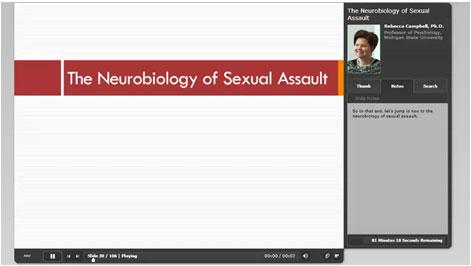

Neurobiology of Sexual Assault


Neurobiology of Sexual Assault: Trauma and Impact on the Brain


Neurobiology of Sexual Assault: Trauma and Impact
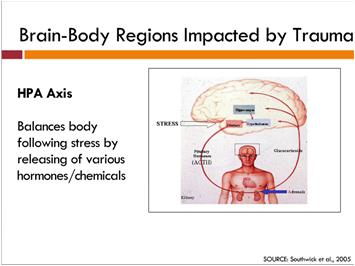

Neurobiology of Sexual Assault: Trauma and Impact on the Brain


Neurobiology of Sexual Assault: Trauma and Impact on Memory
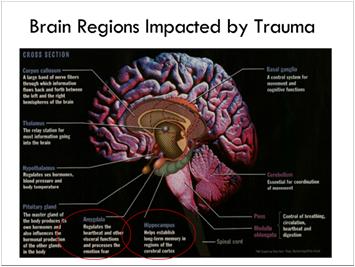

Neurobiology of Sexual Assault: Trauma and Impact
Memory
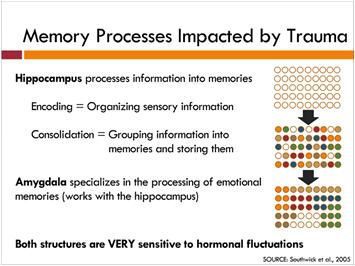

Neurobiology of Sexual Assault: Trauma and Impact on Memory
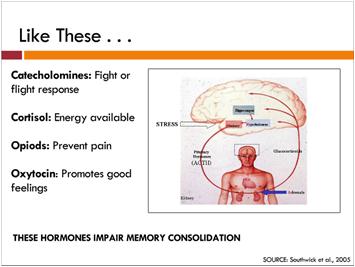

Neurobiology of Sexual Assault: How Does This Play Out in Sexual Assault?
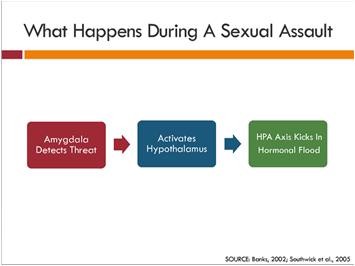



Neurobiology of Sexual Assault: How Does This Play Out in Sexual Assault?
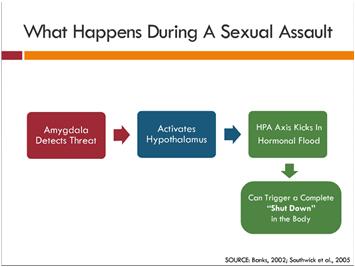

Neurobiology of Sexual Assault: How Does This Play Out in Sexual Assault?
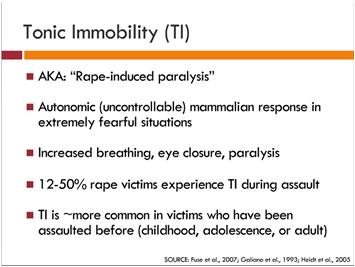

• Flight/Flee –Try to run or get away from the threatening situation
• Fight – Body tries to fight back against the traumatic event
• Limits Rational Thought Process
• Flat Affect
• Freeze –Unable to move or fight back

Neurobiology of Sexual Assault: What Happens in Terms of Memory?
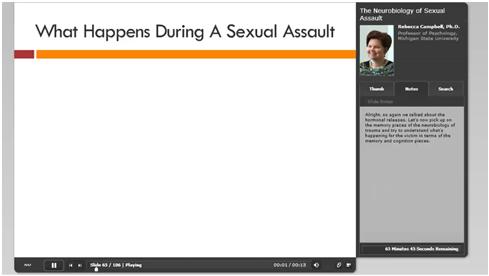

Neurobiology of Sexual Assault: What Happens in Terms of Memory?
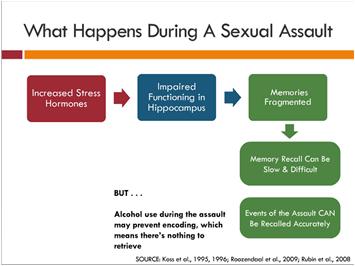

Neurobiology of Sexual Assault: What Does This Mean For Practitioners?
• Neurobiological changes may result in flat affect or perceived “strange” emotions
• Neurobiological changes may impact memory consolidation and recall
• Slowed recall
• Disorganized and fragmented
• Memory piecemeal
• If alcohol was involved the memory may not be retrievable

Related Concepts to Consider
• Secondary Victimization
• “the victim-blaming attitudes, behaviors, and practices that exacerbate sexual assault survivors’ trauma” or cause them to relive it
• “made them feel guilty, depressed, anxious, distrustful of others, and reluctant to seek further help” questions about decision-making, alcohol consumption, sending mixed signals, or appearance/clothing
• Use of sensory information to help recall memory affected by experiencing trauma
Asking about what the person could see, smell, taste, feel, or hear

Womble Bond Dickinson gratefully acknowledges the U.S. Department of Justice, Office of Justice Programs, National Institute of Justice, for allowing us to reproduce, in part or in whole, Dr. Rebecca Campbell’s The Neurobiology of Sexual Assault. The opinions, findings, and conclusions or recommendations expressed in this video are those of the speaker(s) and do not necessarily represent the official position or policies of the U.S. Department of Justice. Thank You




Phase: Gather Evidence —Notice of Meetings
Title IX:
Parties must be given written notice of the date, time, location, participants, and purpose of all hearings, investigative interviews, or other meetings where the party’s participation in such meetings is invited or expected. The written notice to the parties of such meetings must be provided with sufficient time for the party to prepare to participate.
VAWA:
Both parties are to receive timely notice of meetings in which either might participate as part of the informal or formal disciplinary process

Phase: Gather Evidence
Begin preparation of your investigative report:
• Develop a template for the structure
• Know the scope (fact gatherer and reporter, single investigator, credibility assessments, recommendations?)
• Stay organized throughout the process and build the report and evidence as you go
Create your interview summaries as you go
• Compile and organize documentary evidence
Include meetings and other case events and timelines in working draft as you go
• Start to identify “directly related” evidence that is distinct from “relevant evidence”

Putting Training into Practice: Investigation Techniques for Interviews
• Be thoughtful about the time of the interview, time allotted, and location
• Make the party comfortable and develop some rapport
Be empathetic
Be patient, do not rush: slow down, give them space to think and answer
Use open-ended questions, allow for them to answer questions in the narrative (especially in the initial interview)
• Try not to interrupt narrative
• Do not form judgments based how they are acting/presenting
Demeanor or emotions (trauma informed/stressful process)
Alcohol can impair memory
Avoid secondary victimization (complainant)

Putting Training into Practice: Investigation Techniques for Interviews
Beyond being impartial and not prejudging, take steps to help communicate your impartiality during interviews:
Avoid confusion: explain and establish your role clearly and early and return to it as needed throughout the interview and process
• Demonstrate impartiality through neutral language
Do not use conclusory language about contested or unknown facts
Do not appear to take sides or even agree with the party/witness account
Do not appear to provide support (“I’m sorry this happened to you”) but you should be familiar with the resourcesavailable and be able to reference them/information about them
Use terms “account” or “experience,” not “story” or “version”
Maintain your calm demeanor
Do not react or supply energy to the information received or interview generally (words or expressions/body language)
Stay engaged
• Stick to your role, any deviation can be confusing, cause mistrust, or create appearance of bias

Phase: Gather Evidence —Interviews
Questioning:
• Start with opening script
• Goal is to collect the full account of the events surrounding the allegation, typically through narratives (take note of new allegations)
Try to obtain the information necessary to create a timeline for the events (even if they do not recall the specifictime)
Want information to recreate the scene: who, what, when, where, and how
Start with open-ended questions to obtain account
Keep the conversation open-ended and flowing throughout (“And then what happened”)
Listen carefully to the responses to formulate follow up questions
Limit follow up questions to information necessary to understand the account
If you are not sure, do not ask
• Do not frame questions that in a way that shares information, unless it is truly necessary
• Distinguish personal knowledge and secondhand information

Phase: Gather Evidence —Interviews
Questioning (cont.):
Do not “confront” them with other accounts or evidence (in initial party interviews)
• Ask clarifying questions for descriptions or words with multiple or unclear meanings Clinical terms instead of “did it,” “had sex,” “oral,” “got together,” and “hooked up”
Do not draw a conclusion because it might seem self-explanatory
Ask questions seeking all relevant information, even if they are very personal and uncomfortable
Avoid “why” questions (unnerving, feel and sound judgmental)
Recap, restate, or summarize what they have said, in the way they said it
Do not interpret or change the wording
Complete the “chapter”
• Closing script
• Write up your notes as soon as possible afterward (summary/draft report/recording)


•
•
•






Annabelle’s Interview

The night before her interview, Annabelle emails you to say that she is suffering from panic attacks and having severe anxiety. She tells you she will not be able to attend the interview. She said she will contact you later when she is ready.

What do you do? Do you allow this delay?

• How do you include information about the delay and reasons for it in the investigative report? Moving Forward

• The Title IX Coordinator calls you after talking with Annabelle. They agree that Annabelle will reschedule the interview for the following week.

Interview


During one of Annabelle’s answers to your questions, she makes a passing comment that Jake keeps retaliating against her.

Annabelle’s Interview


During the interview, Annabelle tells you she received a phone call from a graduate student who is one of the baseball team’s equipment managers. She said he asked her to tell him her version of the story about what happened with Jake.
Is this “relevant” or important information?


Jake’s Interview




Interview


During Jake’s interview, he tells you that the parties had an agreement during informal resolution until Annabelle said she wouldn’t sign it at the last minute. He also tells you that Annabelle basically admitted to the facilitator that she wasn’t incapacitated that night.

Jake’s Interview


Jake tells you that this process has been incredibly difficult on him and his family. He said the worst part was when the baseball coach told him to stay away from the team a few weeks ago.
What should you do?

Jake’s Interview
After you turn off the recording device, Jake and his advisor are talking and then Jake starts talking to you again. He starts telling you about how the parties took an Uber ride back to Annabelle’s dorm that night and everything Annabelle said and did in the car.
How do you handle it?


Jake’s Evidence
After the interview, Jake sends you several videos he said Annabelle posted on social media the night after they had sex. The videos show Annabelle doing shots, laughing with friends, and sitting in someone’s lap kissing them.
In one of the videos, Emily is wearing a TBU baseball hat and can be heard saying, “Let’s go catch a rapist, Annabelle!” while making the air quotes sign when saying the word “catch.” Jake writes in the email that no person who believes they were assaulted would ever be acting like that the very next day. He tells you this important evidence proves that Annabelle is lying.
What should you do?


Phase: Gather Evidence —Special Considerations For Follow Up Interviews
Party follow up interviews:
Complete draft investigation report prior to follow ups
Evaluate all of the evidence to know differences in accounts and inconsistencies or conflicts with own account, other accounts, and other evidence
• Outline the follow up interview
• Not a re-examination: collect the information you need to complete the account/fill in any gaps
• Ask follow up questions based on evidence collected (from all sources)
• Offer the opportunity to respond, if they wish, to other party’s information Ask suitable “cross-examination” questions from other party’s list

Annabelle’s Follow-Up Interview


During Annabelle’s follow-up interview, you offer her the opportunity to respond to Jake’s account of the sexual contact in the bedroom, which included details about the choking. Annabelle tells you that she has never been choked during sex in her life, at least that she can remember. She tells you she would never consent to being choked in any form.




Phase: Gather Evidence —Interviews
Remember specific Title IX exclusions (evidence that is “not relevant”):
Do not ask about prior sexual predisposition or sexual behavior of the Complainant, unless:
The questions (or evidence) are related to prior sexual contact with the respondent and are offered to prove consent, or Respondent alleges someone else committed the conduct
• Privileged records–do not ask/initiate discussion about them:
Medical, psychological, or similar treatment records
• Attorney-client
• Clergy
Spousal
• Privilege can be waived through “voluntary, written consent”

Phase: Gather Evidence —Beyond Interviews
Other Common Categories of Evidence:
Texts, chats, and other electronic messages/communications
Photos and videos
Voicemails
Recordings (thorny)
Emails
Social media posts
• Surveillance video
• Access data: Wi-Fi, key card
• Police report
• Medical and treatment records (must have a written waiver)
• Employment/student records
Diagrams, maps, and drawings

Phase: Gather Evidence—Beyond Interviews
• Title IX Regs prohibit categorical exclusion of evidence
• Common examples of evidence institutions previously excluded or typically deemed not relevant include:
Lie detector results
• Expert reports
Medical records, including rape kits
• Character evidence
Prior bad acts
Witness statements submitted by party or their advisor
• Unduly prejudicial/evidence “whose probative value is substantially outweighed by the danger of unfair prejudice”






Checklist for Closing Investigation Process
• Confer with Title IX Coordinator about timing and mechanics of providing “copies” to parties and their advisors for review (Title IX)
• Can be provided in electronic form, including, for example, a link to the files
If a VAWA case not proceeding under the Title IX policy or procedures, this probably occurs in conjunction with providing parties accessto the finalinvestigative report

Checklist for Protecting the File
Prior to providing the “directly related” evidence (or the report for VAWA) to the parties, build in protections:
• Remove or redact information that is not “directly related”
Require parties and their advisors to use the evidence and any report only for the purposes of the institution’s process
Prohibit parties and advisors from sharing the documentation or disclosing the information to others
Non-disclosure agreement?
• Use digital encryption to protect privacy
• Use party-specific watermarks
• Use the same practices for the final report


Should you include this evidence of Annabelle’s motive?


Phase: Finalize Investigative Report
• First: Review and consider any response received
• Confer with Coordinator about any response received
• Determine whether further investigation, interviews, or follow-up is needed
• Identify evidentiary or relevance issues
• Determine whether you need additional expertise
• Then:
• Draft the final investigative report

Call
A few days later, Jake calls you again. He tells you that he needs a delay in the process because his attorney is working to obtain all Snapchats between him and Annabelle. The attorney is also trying to obtain all of Annabelle’s messages from October and November 2021.



Title IX Coordinator’s Call
The Title IX Coordinator calls you to say that, after meeting with Annabelle, it has been decided that the allegations will not be changed and to proceed with finalizing the investigative report.




Final Reports



Phase: Finalize Investigative Report
After the review and response period:
• Title IX
Create an investigative report that fairly
Investigator
• VAWA:
•

Phase: Finalize Investigative Report
Relevant evidence:
“The final regulations do not define relevance, and the ordinary meaning of the word should be understood and applied.”
“Focus investigations and adjudications on evidence pertinent to proving whether facts material to the allegations under investigation are more or less likely to be true (i.e., on what is relevant).”

Phase: Finalize Investigative Report
Preparation:
Develop a template for the structure
Identify the scope (fact gatherer and reporter, single investigator, credibility assessments, recommendations?)
• Stay organized throughout the process and build the report and evidence as you go
• Create your interview summaries as you go Compile and organize documentary evidence
• Include meetings and other case events and timelines in working draft as you go
• Identify “directly related” evidence that is distinct from “relevant evidence”

Phase: Finalize Investigative Report —Overview of Potential Report Elements
A. Introduction
B. Summary of the Allegations and Complaint
C. Documents/Evidence Reviewed (if too many, appendix)
D. Interview Methodology
E. Witnesses Interviewed
F. Factual Summary
G. Recommendations (for non-Title IX, if applicable)
H. Conclusion

Phase: Finalize Investigative Report —Introduction
• Source, recipient, and date of report/complaint
• Date of the notice of allegations/investigation
Reason for the investigation
Your appointment as the Investigator (reference policy)
• Your role (investigator, single investigator, credibility, recommendations?)
• Date of the close of evidence
• Date the parties received directly related evidence and description of the form*
• Date the parties provided responses to directly related evidence* and report *for Title IX investigations

Phase: Finalize Investigative Report —Summary of Allegations
A very brief summary of the allegations made/prohibited conduct usually a paragraph similar to description in the Notice of Allegations
• Date/timing of the allegations
• Specify the same for amended or additional allegations
• Include allegations made by the other party if the investigations are consolidated

Phase: Finalize Investigative Report —Documents/Evidence Reviewed
• List the “relevant” documents item by item (and attach them)
Describe the evidence, identify the source and time
E.g.: November 1, 2021 text messages between Complainant and Respondent provided by Complainant
• Provide a description for documents received but not deemed relevant (and not attached –primarily for non-Title IX cases where directly related evidence is not shared)
• Party responses to the “directly related” evidence or the final report (depending on your process)

Phase: Finalize Investigative Report —Interview Methodology
• Items from opening script:
• Role Confidentiality (your treatment and, for witnesses, their adherence)
• Retaliation policy
• Asked general questions and follow-up questions when necessary
• Limitations on sharing of information
• Offered opportunity to provide evidence and suggest witnesses (and basis for suggestions)
• Parties’ opportunities to suggest questions to ask the other party during investigation process

Phase: Finalize Investigative Report —Witnesses Interviewed
• Names of witnesses and those present (advisors, too)
• Date(s) (interviews and communications with them)
• Location
• Note the reasons for the interview (party request?)
• If recorded, note it
For those suggested but not interviewed, note the reasons
Identify efforts to interview witnesses who did not agree to participate

Phase: Finalize Investigative Report —Factual Summary
Determined by your institution’s practices
• For most cases:
Background section (parties’ description of their relationship to each other and to witnesses, witnesses’descriptions of relationships to parties)
Organize the facts by in chronological order by allegation/event (Complainant’s account, Respondent’s account, Witness accounts)
Weave in other evidence provided
• Recited neutrally and consistently
E.g., Annabelle stated/said, Jake stated/said or “The parties agreed” for each fact
Avoid words like “according to,” “admitted,” “acknowledged,” “conceded,” ‘”explained,” “described,” “recalled,” “remembered,”or“opined”unless theyuse those words
Include facts necessary to decide case, including those related to credibility (and address it if that is part of your role)
• Separate section for recommendations

Finalize the Investigative Report and Provide it to the Parties
Title IX:
• Similar to the “directly related evidence,” must provide electronic or hard copy to party and advisor
10 days prior to any hearing
• Must provide parties opportunity to provide written response
All evidence subject to review and response by the parties must be available at the hearing
• Can institute same types of protections (NDA, limitations on use of information, encryption, watermarks)

Finalize the Investigative Report and Provide it to the Parties
VAWA:
• Permitted to control access to information relied upon by any decision-maker permitted
• Supervised reviews (without smart phones)
• Confidential: no copies, photos, or downloads
• If remote, replicate in-person protections:
• Controlled and supervised access
• Secure site, monitored through Zoom
• Advisor’s access through party

Jake’s Response
In his response to the Final Investigative Report Jake says: I do want to clarify what I told the investigator. The investigator left out important information. When I told him that I was checking in with Annabelle during the sexual activities, that included me “specifically checking in on consent.” I did not see that specificity in the report.
• What do you do?



Decision-Making




Decision-Making
Similar and identical requirements for decision-makers:
Process must be prompt and fair
Impartial: bias and conflict free, avoid prejudgment of facts
• Objective evaluation of all relevant evidence
• Both inculpatory and exculpatory
Address evidence that supports the conclusion
Address certain evidence that is contrary to the conclusion (take on material information)
Credibility not based on status (complainant, respondent, or witness)
Make determination independently (no deference to investigative report)
Reminder about Training Requirements
On technology to be used at the hearing
Issues on relevance of questions and evidence, including sexual predisposition and prior sexual behavior
• Institution’s policies, including definitions

Decision-Making —General Requirements of Title IX Hearing
• Live hearing
In-person, with separation of parties (upon request) or virtual
All “directly related evidence” available
• Provide cross-examination: permit each party’s advisor to ask “all relevant and follow-up questions” of the other party and witnesses
• Institution provides advisor for cross-examination if the party does not have one
Decision-maker determines relevancy for each question and party must be afforded the opportunity to challenge relevancy determinations
Cannot require participation of party or witness
Audio recording or transcript
• Issue a written determination of responsibility

Decision-Making —Title IX Hearing
Flexibility (must apply equally):
• To determine advisor role beyond cross-examination
• Choice of decision-makers
• Use of pre-hearings
• Format of hearing beyond cross-examination
Openings? Direct examination? Closings? Arguments on evidence?
In-person, with separation of parties or virtual
• Decorum (to make the process respectful and professional)
• Handling objections
• Time limits for various phases of hearing

Decision-Making —Title IX Hearing
• Ensure that you clearly understand your role in the hearing process
Testimony?
Subject to cross-examination? Bring or present evidence?
• Scope/rules for questions to you? Provide recommendations or weigh credibility?
Seek any clarity about your role or the evidence from Title IX Coordinator, not decision-makers
No “ex-parte” type conversations with decision-makers
Same approach to non-Title IX decision-making

• Keep in mind what must be decided:
• Make a decision about whether the policy was violated
• For sexual harassment: determine what conduct occurred and whether it was welcomed or unwelcomed For sexual contact: what conduct occurred and was it with consent or without consent
• Using the applicable standard of evidence
• With rationale for finding on each allegation
• Sanctions (institution-specific)
• Remedies (institution-specific)

Decision-Making
Standard of evidence:
Preponderance: more likely than not that respondent violated the policy (50% and a feather) or insufficient evidence to conclude it is more likely than not
Clear and convincing: “highly probable” or insufficient evidence to conclude it is “highly probable”
• Under Title IX, must apply the same standard of evidence to all Formal Complaints of sexual harassment

Decision-Making —Evidentiary Issues
Always irrelevant under Title IX:
• Complainant's sexual predisposition or prior sexual behavior (unless one of the two exceptions apply)
• Medical, psychological, or treatment records (without voluntary, written consent)
• Information protected by legally recognized privilege without a waiver
• Party or witness statements that have not been the subject of cross-examination at a live hearing
• Know your policy and procedures

Decision-Making —Evidentiary Issues
Determine weight to be given to relevant evidence:
• Regs require consideration of both inculpatory and exculpatory—what does that mean?
• Address evidence that supports the finding/conclusion
• Best practice to address certain evidence that does not support the finding/conclusion—acknowledge and address it (including witness or party statements)
Explain factors for some evidence “outweighing” other evidence—what are the reasons?
What about matters that feel like one person’s word versus another’s? How do you evaluate credibility?

Decision-Making —Evidentiary Issues
Credibility:
• Credibility cannot be based on status (complainant, respondent, or witness)
• Is there corroborating evidence and information Objective documentation Contemporaneous accounts and information
• Is it based on firsthand knowledge—how did the person obtain the information
• Is the information “plausible”
• How strong is their recollection or confidence in the accuracy of the information
Was the person forthcoming with the material information and timing of disclosure

Decision-Making —Evidentiary Issues
Credibility (cont.):
• Does the person have a reason to not be truthful about that information
In both directions: self-serving statements and statements against interest (if the fact is harmful to the person but they disclose it anyway)
• Relationship of person providing information to each of the parties
• Other factors impacting believability?
• Prior bad acts or pattern of this conduct
• Substantially similar and distinct conduct? Allegations or determinations?
• Timing?
• Demeanor?







Decision-Making Phase: Draft Notice of Determination


Decision-Making —Written Determination
Elements:
1. Identification of the allegationsalleged to constitute sexual harassment;
2. Procedural steps taken from receipt of the Formal Complaint through the determination regarding responsibility (writings, meetings, interviews, reviews, hearings, evidence collected);
3. Findingsof fact supporting the determination;
4. Conclusionsregarding the application of the recipient’s code of conduct to the facts;
5. Decision-maker’s rationalefor the result of each allegation, including rationale for the determination regarding responsibility;
6. Any disciplinary sanctionsimposed on the respondent, and whether the recipient will provide remediesto the complainant; and
7. Information regarding the appealsprocess
* Only one notice (re: responsibility with sanctions/remedies) and must be provided to the parties simultaneously

Phase: Decision-Making —Draft Notice of Determination
Title IX and VAWA require a written Notice of Determination (policy determines whether it is required for
IX sexual harassment)
Sample format of Notice of Determination (which aligns with both):
Summary of allegations
Summary of procedures
Policy Provisions Section Findings of Fact Decision and Rationale Sanctions and Rationale • Remedies

Phase: Decision-Making —Draft Notice of Determination
Title IX requires that it include:
• Identification of allegations potentially constituting sexual harassment
Summarize the allegations contained in the Formal Complaint
All allegations, for both parties, in a factual and concise manner
• Description of the procedural steps from formal complaint through determination, including all:
• notifications to parties interviews with parties and witnesses
• site visits
methods used to gather other evidence any hearing held
Include information about who was present and their roles

Phase: Decision-Making —Draft Notice of Determination
Policy Provision Section:
Identify the polices at issue
• Include applicable Definitions
• Regarding conduct (e.g., sexual assault, consent, incapacitation) and the elements
• Standard of proof Burden of proof
Presumption of not responsible
Retaliation, if applicable

Phase: Decision-Making —Draft Notice of Determination
Findings of fact supporting the determination
Conclusions regarding application of policy to the facts
• Statement of, and rationale for, the result as to each allegation, including determination regarding responsibility, sanctions, and whether remedies designed to restore or preserve equal access to education program/activity to complainant
In practice:
Discuss all material facts
Apply the policy definition and standard of proof to the facts
• To reach conclusions that are
• Explained through the evidence available, how it was weighed, and how it supports, or does not support, the outcome (including credibility)

Phase: Decision-Making —Draft Notice of Determination
Findings and Rationale (cont.)
• Sanctions and Rationale
• And procedure for failing to abide by them
Remedies provided

Phase: Decision-Making —Draft Notice of Determination
Procedures and basis for appeal
• Explain the process, general requirements, roles, and the timeframes
• Permissible grounds for appeal
How to file it
On what timeline
To be decided by whom (by name, title, or otherwise)
• Appeal bases must include:
Procedural irregularity that affected the outcome
New evidence that was not reasonably available at the time the determination regarding responsibility (or dismissal) was made, that could affect the outcome
Title IX Coordinator, Investigator, or decision-maker(s) had a conflict of interest or bias for or against complainants or respondents generally or the individual complainant or respondent that affected the outcome
Plus any other grounds listed in the policy

• Final at conclusion of appeal or, if no appeal is filed, on the date on which the appeal would no longer be considered timely Phase: Decision-Making —Draft Notice of Determination
Delivery of the Notice of Determination (Title IX):
Know in advance who is responsible for delivering the notice to the parties
Must be a written notice
• Must provided to the parties simultaneously
Sexual Assault and VAWA crimes:
• Simultaneous notice, when the decision becomes final AND for any change to the results prior to it becoming final
Effective Date (Title IX Regs) for Findings:

Phase: Decision-Making —Sanctions and Remedies
Know your role
Separate the finding on responsibility from the sanctions and remedies
If credibility is part of the sanctions determination, whomever makes credibility determinations should decide sanctions
• Know your process
• Based solely on the investigation and hearing files?
Parties to submit impact statements?
Sanctions and remedies should align with the determination
“Close evidentiary calls” do not warrant lesser sanctions
Evidentiary standard should not be raised because of the severity of the sanctions
• Designed to stop the discriminatory conduct, prevent its recurrence, and address its effects

Phase: Decision-Making —Sanctions and Remedies
• Range of possible sanctions should be listed in your policy (required by VAWA)
• Requires the sanctions to be specific, including the type and length of suspension and reinstatement requirements
• Must be included in notice of determination
• Any information relied upon by decision-makers must be available to parties
• Sanctions must be included in the singular Notice of Determination (Title IX)
• Policies list the range of sanctions and sanctioning considerations

• Additional written and notice requirements as well Decision-Making —Appeals
Pertinent Title IX Requirements (not exhaustive):
• Equitable Offered to both parties from: decision and from dismissal of Formal Complaint
• Required Grounds: Procedural irregularity that affected the outcome New evidence that was not reasonably available at the time the decision was made and could affect the outcome
• Bias or conflict by Title IX Coordinator, investigator, or decisionmaker
• Permitted to provide additional bases for appeal, as long as equally

Phase: Decision-Making —Appeals
• No appeal requirement but, if provided, it must be offered equally to the parties with the same procedural protections as provided throughout the process

Recordkeeping —Title IX
Must maintain certain records for seven years, including:
• For each sexual harassment investigation including any determination regarding responsibility and any audio or audiovisual recording or transcript required by the Regulations, any disciplinary sanctions imposed on the Respondent, and any remedies provided to the complainant designed to restore or preserve equal access to the education program or activity
Any appeal and the result
• Informal resolution
Supportive measures
Training materials for Title IX Coordinators, Investigators, decision-makers, and those who facilitate informal resolution (and post on website)
Actions taken in response to a report or formal complaint sufficient to document why the response was not deliberately indifferent






• November 10, 2022: Title IX Hearing Officer and Decision-Maker Training
Coming Soon:
• Appeal Officer Training
• Hearing Advisor Training
• Title IX Coordinator Training
• All trainings will also be available on demand

